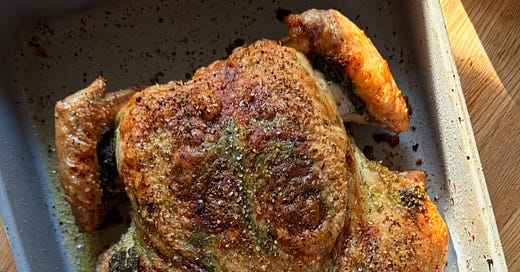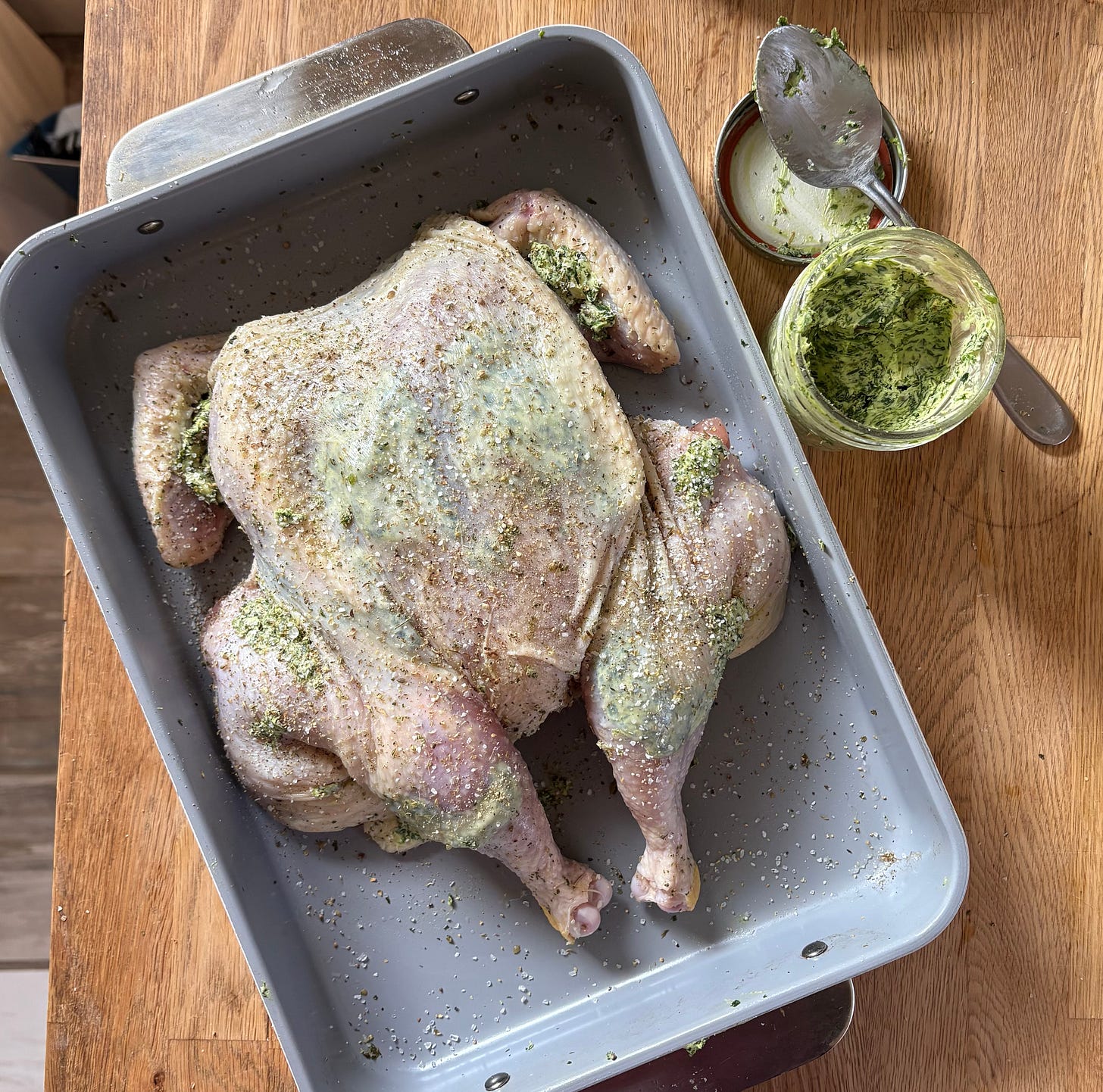The ingredients:
Roasted chicken:
1 c. salt
3-4 pound chicken
1 tsp. garlic powder
1 tsp. oregano
1 tsp. black pepper
1/2 lemon
4 tbsp. ramp compound butter
The process:
About 12 hours before cooking, take your chicken and cut the spine out, flip over and push the ends of the drumsticks outward, flattening the thigh. Take the butt of your hand and press on the breastbone until it pops. Congratulations, you’ve spatchcocked a chicken! Cover generously with the entire cup of salt, rubbing the skin with it. Refrigerate. Once ready to cook, preheat oven to 425. Remove chicken from fridge and brush all salt off. Take your fingers at the top of the breastbone and find where the skin and breast meet. Wriggle your fingers in between, creating a pocket between the two, and then wedge ramp butter as far under the skin as the chicken will allow without ripping it.
Place one (or two, if you’re crazy) lemon halves underneath the chicken, pulp-side up, to help keep the chicken from the bottom of the pan. Season the chicken with oregano, garlic powder, and black pepper (No need for additional salt—the skin will have absorbed plenty). Cook at 425 for approximately 40-50 minutes, or until the chicken reads 165 with a thermometer. Allow to rest for 20 minutes.
The story:
There are so many stories here. The quick one is how my roommate, Dave, taught me my preferred way of roasting a chicken, which is salt-brined and buttered to hell and back. The salt brine is a surefire way to ensure your chicken skin is crispy, while allowing the meat to stay insanely juicy. My approach is that the lemon moisturizes from the bottom, that layer of buttery fat moisturizes from the top, and the skin is allowed to get that golden color with little charred bits of seasoning. It’s divine.
The ramp butter is a love letter to back home. Growing up, we used to go to the ramp festival in Reliance, Tennessee which is as much of a trip as it sounds like. Before fancy chefs in New York touted their favorite Appalachian spring allium as exclusive and folksy, I was eating them pickled or with eggs or on beans with a healthy serving of bacon way back in the mountains, far beyond the reach of phone service. Note: if memory serves me correct, there was also a Miss Ramp Festival, though it seems that honorific was retired before I could rightfully ascend to the throne!!! What I loved about the Ramp Festival though is that we’d take probably an hour drive to go, and it wasn’t high-end chefs with those annoyingly small quick bites that leave you hungry. It was people whose mamaws passed down the recipes they used growing up. It’s for face painting and trekking into the woods to go collect ramps. (Fun fact: one time, my dad got into a fist fight at the ramp festival because someone was being rude!) But the point, I guess is that the core of the ramp festival is about humble recipes that don’t aim to reinvent the wheel—they’re just happy to be celebrating that the wheel exists, you know?
Ramps are one of my weird little niches that connects me to home. They’re foraged, so they’re harder to find than, say, leeks or green garlic. You mostly have to keep an eye out at farmer’s markets, and there’s been a nice push in recent years to sustainably farm them, leaving the bulbs planted and only harvesting the leaves to ensure they continue to grow back. I get defensive over ramps because, like so many ingredients that come from poor and marginalized parts of the world, sometimes I feel like they’re a plaything for the wealthy, when in reality, they’re a cultural identifier and a pungent onion-y/garlic welcome mat for Spring.
So every year, I find as many as I can and make sure to preserve them in a way that lets me use them all year long. I’ll be taking about a stick and a half and freezing it, so that in October when I’m bummed they’re not around, I can pop open the freezer and surprise myself.






